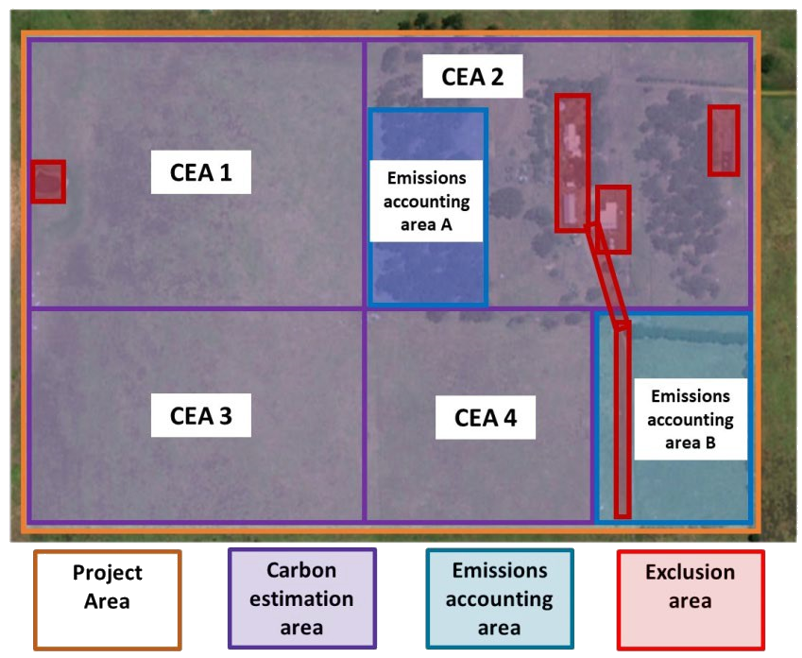We are helping you navigate your way around project areas, carbon estimation areas, emissions accounting areas, and exclusion areas.
The Australian Government’s Soil Carbon Method 2021 can be a difficult beast to tame. That’s why, we’re here to help you understand its complexities.
In this blog, we will explore the four types of ‘areas’ that you will come across when undertaking a soil carbon project:
- Project areas,
- Carbon estimation areas,
- Emissions accounting areas and
- Exclusion areas.
It is important to have a sound understanding as to what these are, and how these should be used across your farm to ensure compliance with the methodology.
Project Areas
One of the first requirements in establishing a soil carbon project under the ACCU Scheme method is defining your Project Area (PA). A Project Area is the boundary within which your soil carbon project will operate – and within which all other areas must fit!
It is usually easiest to capture your entire farm boundary. That way, when you are collating farm data for reporting purposes, you can easily utilise your whole farm data. Not doing so may mean you have to undertake calculations to separate whole farm data (such as fuel use) between what is within the project area and what is outside it.
Despite this, there are no restrictions as to how you draw your project area boundaries (as long as it is on land that you own, lease or have a legal right to undertake the project on). So, if you are only wanting to conduct a soil carbon project over part of your farm, you can map your boundaries to suit your operation. We suggest using title boundaries or fence lines, as these provide hard, defined boundary limits.
However, you will need good record keeping to make it easy to assign farm emissions appropriately – such as how many days your livestock has spent on each paddock.
The decision to nominate the project boundary as either your entire farm or as a portion of it is largely yours to make – and we can help you weigh up what is best suited to your operation.
Carbon Estimation Areas
Carbon Estimation Areas (CEA’s) are those areas in which you will be conducting soil sampling and your eligible land management activities. This makes them one of the easiest areas to define. Essentially, if you are undertaking an activity to improve soil carbon and want to measure these gains, you will need to include the area in a CEA. The emissions that occur in a CEA also need to be measured and included in the project’s emissions records and contribute to your net abatement.
How you define the boundaries of a CEA will be guided by your land management strategy, your paddocks, and your stratification approach. Check out our educational webinar on Soil Carbon Baselining with Sam Duncan from FarmLab to understand more about stratification.
Emissions Accounting Areas
Emissions Accounting Areas (EAA’s) are those in which agricultural land-uses are occurring, but you are not planning to conduct eligible land management activities on (and will therefore not be sampling from).
This may be because the land contains forest or bush (but you still graze livestock through), is too rocky or steep to conduct sampling or is a productive area in which you simply decide not to undertake any eligible land management activity. Whilst you will not conduct soil sampling on these areas, you will need to account for any emissions that take place on these and include them in your overall farm emissions calculations.
Exclusion Areas
Exclusion Areas (EA’s) are areas in which no direct agricultural activity is taking place. As such, no sampling is to be taken, and no emissions records need to be kept. These areas are usually easy to mark, as they generally correlate to the presence of infrastructure – i.e., dams, sheds, homes and roads.
Illustrative example
The example below from the 2021 Soil Carbon Simple Method Guide shows how you may divide your property up into these different areas when mapping out your project.

Key considerations
Now that you’re comfortable with your understanding of the areas within a soil carbon project, it is worth familiarising yourself with some key rules for the use of these:
- These areas must all be defined and confirmed prior to conducting your baseline sampling round.
- Once EAA’s and EA’s have been defined, they cannot be changed to a CEA. Ensure you are certain you will not want to conduct any eligible management activities within these areas in the future before proceeding.
- Similarly, CEA’s can be converted to EAA’s after baselining, but there are restrictions around this.
For a full understanding of the 2021 soil carbon method, head to the Clean Energy Regulator’s simple method guide here.
Ready to find out more?
Explore our range of educational resources in our Carbon Farming Education Hub where we frequently publish educational articles, webinars, and guidebooks.
When you’re ready to explore the feasibility of undertaking a carbon project on your property, email us at [email protected] or give us a bell at (08) 6835 1140 to be connected with one of our project facilitators.


![AFN – Cert Accredited Expert [RGB] AFN - Cert Accredited Expert [RGB]](https://carbonfarming.org.au/wp-content/uploads/elementor/thumbs/AFN-Cert-Accredited-Expert-RGB-e1725255016744-qti2uogw4b9a3s6au2d1bbf4utb8ggjuwvkj4qpce8.png)